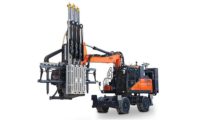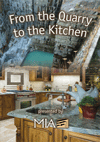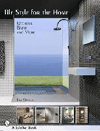
Cowboys Stadium has opened its inaugural season in Arlington, TX, and it has already taken its place among the world’s finest sports venues. The facility features high-end stonework throughout, including the concourses, suites, lounges and other public spaces. Much of the interior stonework for the stadium was supplied through Stone Marketing International (SMI) of Houston, TX.
When Cowboys Stadium made its regular season debut for a national television audience in September, legendary broadcaster Al Michaels referred to the facility as a “palace.” And while that may be the first time the term “palace” has been associated with a sports venue, it is a fitting description for a facility that was designed in a style befitting a five-star resort - including lavish use of stone throughout.
Designed by HKS Sports & Entertainment Group and built by general contractor Manhattan Construction Co., the $1.1 billion stadium includes seating for as many as 100,000 people, 300 luxury suites, club seating on multiple levels and the Dallas Cowboys Pro Shop, which is open to the public year round. The 3-million-square-foot stadium is the largest National Football League venue ever built, and it also represents the biggest column-free room in the world, stretching a quarter-mile in length.

At the Main Concourse, a field of concrete floor tiles is accented by bands of Galactica granite, produced by Marmi Sava srl of Italy. Meanwhile, feature walls are adorned with a custom wall mosaic using tiny mosaic pieces in silver white - key elements of the Cowboys’ color scheme.
“As a team of firsts, this new stadium represents the Dallas Cowboys’ innovation and progressiveness for the future while upholding the traditions of Texas Stadium,” stated Jerry Jones, owner and president of Dallas Cowboys. “The iconic design is architecturally significant and reflects the Dallas Cowboys worldwide brand.”
“In recognition of the time-honored traditions and timeless dynamic nature of the Dallas Cowboys, we chose a modern palette of simple forms and materials that creates a fittingly progressive architectural expression for the new stadium,” stated Bryan Trubey, AIA, principal designer for HKS Sports & Entertainment Group. “Swift form, powerful structure, agile movement and emulated colors serve as a strong link between the architectural form of the building and the primary use of the venue - the home of the Dallas Cowboys.”

A range of materials were used for the bartops in the concession areas, including Galactica granite, which has a “splash of blue that brings a subtle branding element to the spaces,” according to Loretta C. Fulvio IIDA, TAID, Vice President of HKS.
Receiving much of the early publicity as the stadium opened, the world’s largest video board hangs approximately 90 feet above the field from the roof structure. This video center features four individual boards - two facing the sidelines measuring 72 feet tall by 160 feet wide and two facing the end zones measuring 27 feet tall by 48 feet wide.
A rich palette of stone
Going beyond traditional sports amenities, the upscale feel of Cowboys Stadium is generated through the generous use of high-end stone materials. Much of the stonework was supplied through Stone Marketing International (SMI) of Houston, TX, which had previously made its mark in the NFL by coordinating the supply of stone for Reliant Stadium, home of the Houston Texans.
Irma Lovelace of SMI explained that the company worked closely with Loretta C. Fulvio IIDA, TAID, Vice President of HKS, and the stone materials were selected to help achieve the goal of a “modern, but cozy” environment throughout the stadium.
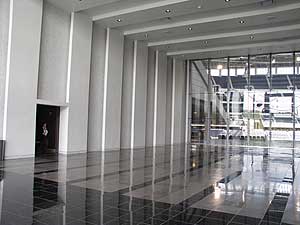
The lobbies beyond the outside entrances feature Galactica tiles on the floor and large-format marble wall mosaics from Island Stone of Santa Cruz, CA.
From the very beginning, Fulvio said that the interior design would “absolutely” include extensive use of natural stone. “The Joneses are clients that are used to refined materials, and they have a great eye,” she said. “They like natural solutions more than faux materials or something that would look like stone.”
To source materials, Fulvio and the stone suppliers made several trips overseas, including a number of trips to the Marmomacc exhibition in Verona, Italy. “I went to [Marmomacc] for the past few years, even before the project began,” she said. “We were looking for stones, and we would always find some new ones. We always went in to find the most unique stones that would relate back to the architecture and back to the Cowboys. We wanted something you just wouldn’t see someplace else.”
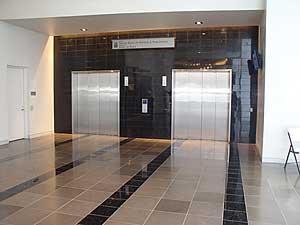
The elevator lobbies at the main level are faced with tiles of Afton Black granite produced by A. Lacroix et Fils Granit Ltée of Saint-Sébastien, Québec, Canada.
In selecting the stones that would be used on Cowboys Stadium, Fulvio and the design team worked very closely with team ownership. “We had a very educated client, and they knew what they wanted,” she said. “It wasn’t just HKS; the client was also very involved with the approval of all final submittals. You’re working with millions of dollars worth of stone, and we had everything mocked up for presentation to the client. They didn’t want stones with heavy movement. They wanted the stones to be tight and clean and beautiful. It all worked out really well.”

The Main Club Level features extensive use of the Galactica granite for the walls, including large-format panels.
At the Main Concourse, a field of concrete floor tiles is accented by bands of Galactica granite, which was produced by Marmi Sava srl of Italy and supplied by SMI. Meanwhile, feature walls in the Main Concourse are adorned with a custom wall mosaic using tiny mosaic pieces in silver and white - key elements of the Cowboys’ color scheme. These mesh-mounted mosaics were installed by Texas Stone & Tile of Carrollton, TX.
Several different materials were used for the bartops in the Main Concourse and the Main Club Area as well as other lounges, and the stones provide a tie-in to the overall color palette. Included are bartops featuring SK marble, a white material that is quarried in Greece. “They wanted something that wasn’t common like an alabaster,” explained Lovelace.
Other countertops in the stadium are made from Galactica and Labrador Antique granite, both of which “had that splash of blue that brings a subtle branding element to the spaces,” according to Fulvio.
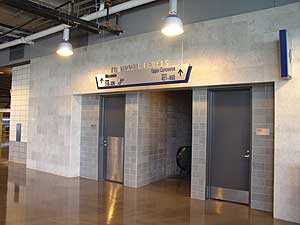
The design of the Main Concourse also includes Portuguese limestone, which was used as wall cladding at the escalator entrances and stairwells leading to the upper levels. Materials included Gascogne Blue - produced by Dimpomar of Portugal.
Meanwhile, the lobbies beyond the outside entrances feature Galactica tiles on the floor and large-format marble wall mosaics from Island Stone of Santa Cruz, CA. The marble wall mosaics were installed by Modern Tile of Garland, TX.
A similar materials pallet was used at the Main Club Level, with more extensive use of the Galactica granite for the walls, including large-format panels. Dee Brown, Inc. (DBI) of Garland, TX, installed all of the interior club areas, stone tops and large-format wall panels.
The design of the Main Concourse also includes Portuguese limestone, which was used as wall cladding at the escalator entrances and stairwells leading to the upper levels. Materials included Gascogne Blue - quarried by Dimpomar of Portugal and supplied through SMI - as well as Blue Monica, supplied by Texas Stone and Tile, which was also responsible for installing the limestone wall cladding.
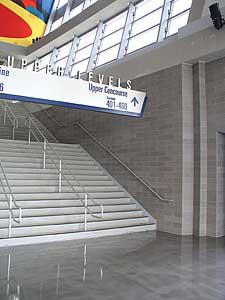
At the stairwell, Blue Monica limestone serves as wall cladding.
Operation of Cowboys Stadium is not limited to games or other events, as the 10,000-square-foot Dallas Cowboys Pro Shop will be open to the public year round, and tours of the facility take place most days of the year. With this in mind, visitors to the Pro Shop and tour participants come into the stadium through what is referred to as the “365 Entrance,” which is more reminiscent of a five-star hotel lobby than a football stadium.
For the 365 Entrance, the design includes floors of Basaltina tiles, which were produced by Basaltina, srl of Italy and supplied by SMI. It also utilizes a very unique material, Polar Black, for the feature wall along the Pro Shop. According to Irma Lovelace of SMI, the material is quarried in Norway above the Arctic Circle, and it has magnetic qualities - unique for a commercially sold stone.

For the “365 Entrance,” the design utilizes a very unique material, Polar Black, for the feature wall along the Pro Shop. The material is quarried in Norway above the Arctic Circle, and it was processed by Marmi Sava. The space also features Basaltina tile flooring, produced by Basaltina, srl of Italy.
The Polar Black panels, which were fabricated by Marmi Sava and supplied through SMI, are separated by horizontal bands of stainless steel, and the contractors made a special effort to achieve the proper aesthetic. “The Polar Black pieces were laid out and numbered before installation so that the pattern could be laid to specifications,” explained Brett Marshall, Assistant Project Manager for Manhattan Construction Co. “The pieces were installed using plaster anchors, which is what was used for all of the stone wall panels.”
Mark L. Timm, IIDA, Vice President at HKS, Inc. was responsible for making sure the “pattern” or “layout” was perfect, and he numbered the back of every piece of stone. Caleb McNeil of Manhattan Construction assisted to insure that the pattern was installed as numbered.

Private luxury suites are located in eight different areas on five separate levels of the stadium. Within the suites themselves, owners were given a choice of three “finish-out” options. Suites with the brown scheme feature Winter Bling countertops, with material imported from Marmi Graniti Favorita of Italy.
Overall, the stone specifications at Cowboys Stadium evolved as construction progressed. “We were hired for the ‘back of house’ stone and tilework, as well as all of the tilework in the locker rooms,” Miller explained. “But the scope of work escalated as we went on. Different packages of finishes were ordered as it went along, and it made for a fast-track project.”
Texas Stone & Tile was also responsible for installing all of the Basaltina in the 365 Entrance and on selected elevator walls. “We had never worked with Basaltina before; it’s a nice product,” Miller said.
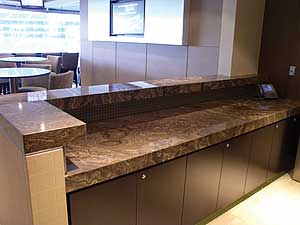
Luxury suites with the beige scheme have countertops of Eramosa, which is quarried in Canada.
Like most stadiums built over the course of the past decade, guest suites were a critical element when planning Cowboys Stadium, and the design team wanted to be certain that they would include a range of premium building materials, including a wealth of natural stone. “We traveled the country looking at suites in other sporting venues as well as some of the finest museums and hotels,” stated Charlotte Anderson, Executive Vice President, Vice President of Brand Management and President of Charity Foundation for the Dallas Cowboys Football Club. “We’ve combined the best amenities with elegant and luxurious surroundings, amazing sight lines and private clubs.”
Anderson pointed out that there are four different types of suites - ranging in size from 650 to 800 square feet - with a maximum occupancy of over 30 people. The suites are located in eight different areas on five separate levels of the stadium.
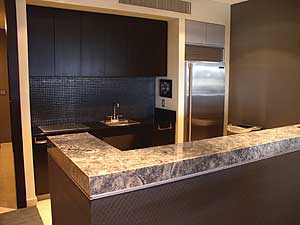
Private suites with the gray scheme have Azul Aran countertops.
Complementing the stone countertops, many of the luxury suites also feature tiles of Serpeggiante, a hard and dense limestone that was produced by Marmi Manzi in the Trani area of Italy. SMI supplied approximately 100,000 square feet of this material, which was personally selected by Gene Jones, wife of Jerry Jones. All Commercial Floors was responsible for installing the limestone.
In addition to the private suites, Cowboys Stadium also houses a number of larger social spaces, such as the American Airlines Lounge, which can accommodate a greater number of fans. This feature of the stadium included Labrador Antique countertops for the bar area as well as concession stands.

Complementing the stone countertops, many of the luxury suites also feature tiles of Serpeggiante, a hard and dense limestone that was produced by Marmi Manzi in the Trani area of Italy. SMI supplied approximately 100,000 square feet of this material, which was personally selected by Gene Jones, wife of Jerry Jones.
The office also features Ostrich slate from India, which was used for both the walls and the floors. The slate for the walls was specified in mesh-mounted pattern of narrow horizontal pieces, while cleft slate tiles were used for the floor. All of the slate was supplied by SMI, and it was installed by All Commercial Floors of Dallas. The stonework in the ownership offices is complemented by a range of high-end woodwork, including Australian Walnut.

In addition to the private suites, Cowboys Stadium also houses a number of larger social spaces, such as the American Airlines Lounge, which can accommodate a greater number of fans.
While the stadium’s arches and glasswork are the predominant elements of the stadium’s exterior, the design also includes the use of natural stone, specifically Adair limestone from Arriscraft International of Canada. The stone was used in rough-faced and honed formats, and DBI served as the masonry contractor for this portion of the project. “[The stone was] fabricated to 12-inch course heights with a split-face and random lengths from 18 to 48 inches,” stated DBI. “The project has a honed coping with split edges. DBI also templated and fabricated all outside corners due to their complexity and mixture of finishes - from split-face to the honed return.”
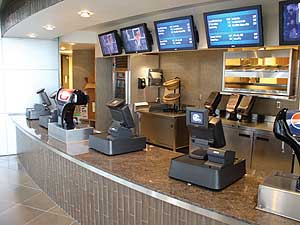
The Americans Airlines Lounge features Labrador Antique countertops for the bar area as well as concession stands.
The project broke ground in April of 2006, and construction lasted more than three years. Outside of the typical challenges of a project as large as the Cowboys Stadium, Marshall said that the project went relatively smooth. “It’s always challenging dealing with overseas lead times in terms of getting materials, but everything worked out,” he said. “And there’s the coordination with all of the trades.”
Moreover, with a George Strait concert confirmed for June 6 of this year, the project had an unyielding deadline for completion. Even though some construction crews remained into the NFL season, Cowboys Stadium had to be functional in time for that first concert date.
In addition to being the new home of the Dallas Cowboys and the annual AT&T Cotton Bowl Classic, the stadium will host the 2011 Super Bowl, the 2010 NBA All-Star Game and the 2014 NCAA men’s basketball Final Four as well as high school and college football, concerts and special events.
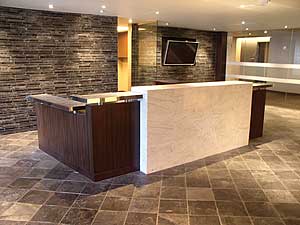
The team ownership offices were designed with a range of custom-fabricated stonework, the centerpiece of which is a reception desk faced with Calacatta marble from Italy. To add a signature look to the marble, the Cowboys classic star logo was etched into the stone. The office also features Ostrich slate from India, which was used for both the walls and the floors.

The exterior of Cowboys Stadium also includes natural stone - specifically Adair limestone from Arriscraft International of Canada.
Sidebar: Cowboys Stadium
Arlington, TXArchitect: HKS Sports & Entertainment Group, Dallas, TX
General Contractor: Manhattan Construction Co., Arlington, TX
Stone Suppliers: Stone Marketing International (SMI), Houston, TX (interior); Arriscraft International, Canada (exterior)
Stone Producers: Marmi Sava srl, Domegliara, Italy; Manzi Marmi, Trani, Italy; Dimpomar, Vila Vicosa, Portugal; A. Lacroix et Fils Granit Ltée, Saint-Sébastien, Québec, Canada; Island Stone, Santa Cruz, CA; Marmi Graniti Favorita, Vicenza, Italy; Arriscraft International, Canada (exterior)
Stone Contractors: Dee Brown, Inc. (DBI), Garland, TX; Texas Stone & Tile, Carrollton, TX; Sigma Marble, Granite and Tile, Dallas, TX; Modern Tile, Garland, TX; All Commercial Floors, Dallas, TX
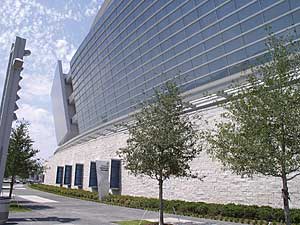
The stone was used in rough-faced and honed formats, and Dee Brown, Inc. (DBI) of Garland, TX, served as the masonry contractor for this portion of the project.
Additional Photos
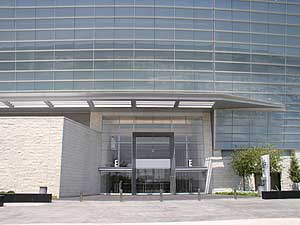
“[The stone was] fabricated to 12-inch course heights with a split-face and random lengths from 18 to 48 inches,” stated DBI. “The project has a honed coping with split edges. DBI also templated and fabricated all outside corners due to their complexity and mixture of finishes - from split-face to the honed return.”
